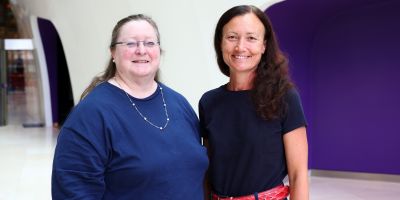University of Leeds uncovers secrets of historic model train with cutting-edge scans

A pioneering model locomotive from 1811 has had its inner mechanics revealed for the first time in over two centuries, thanks to advanced 3D scanning technology from the University of Leeds.
The historic miniature locomotive, displayed at Leeds Industrial Museum, was created by esteemed engineer Matthew Murray just one year before he designed and built the Salamanca, the world’s first commercially viable steam locomotive, in Holbeck. The model helped Murray demonstrate his revolutionary ideas to investors – and therefore played a crucial role in the Industrial Revolution and the history of rail transport.
In its bid to discover its secrets, John McGoldrick, the curator of industrial history at Leeds Museums and Galleries, was assisted by the Bragg Centre for Materials Research, who teamed him up with Dr Alice Macente from the School of Civil Engineering, and Dr Samuel Allshorn from the School of Earth and Environment. They were joined by Dr Michael Bailey, an early railway historian and archaeologist of early locomotive technology.
Together, Dr Macente and Dr Allshorn used sophisticated CT X-ray equipment to uncover the intricacies of its internal workings. The resulting images reveal how closely the model replicated full-sized steam locomotives of the time, which were pivotal to the growth of the railway industry.

The team used the CT scanner to get an intimate look at the model. Image credit: Leeds Museums and Galleries
Dr Macente said: “When John explained to me the nature of the model and its importance, I was fascinated with the idea of using our X-ray CT scanner to inspect it in 3D. We were particularly interested in understanding how the model works and unravel it in 3D, but due to the model size and metal content, it wasn’t possible to use our scanner, which is mostly used for higher resolution and smaller objects.”
She reached out to Dr Allshorn, who manages the Wolfson laboratory in the School of Earth & Environment, where a medical CT scanner is used for larger objects. Dr Allshorn collected several good scans of the locomotive model, before Dr Macente created 3D virtual cuts and 3D renderings, allowing the team to digitally inspect all parts of the model in great detail, including its steam valves, flue, and boiler.
Mr McGoldrick said: “Thanks to these remarkable scans, we can now explore for the first time since 1811 how the model worked, and the extraordinary ingenuity and intricacy which went into its creation.
“Short of cutting open the model, which we wouldn’t ever do, we’d never have got to see its inner workings in quite this way. Now, not only are we examining a piece of engineering history – we’re also getting a unique and unprecedented insight into the mind of one of the world’s great inventors.”

The team was able to visualise the train from multiple angles, uncovering the inner workings of Matthew Murray's groundbreaking model. Image credit: Leeds Museums and Galleries
Dr Macente added: “The most rewarding part of my job is collaborating with people across different areas. I love using non-destructive imaging techniques to give new insights into objects that would otherwise remain unexplored or unseen.
“It highlights the power of CT scanning for museum artefacts, and the importance of teaming up across different facilities to fully unravel the true depths of human creativity.”
The project was part of a collaboration between the University of Leeds and Leeds Museums and Galleries, supported by the Leeds Cultural Institute’s Collections Research Fund. This initiative fosters collaboration between academics and museum professionals to advance understanding of historically significant objects using the latest technological advancements. The scan results will help illustrate how the model worked and its importance in the evolution of global rail transport.
Councillor Salma Arif, Leeds City Council’s executive member for adult social care, active lifestyles, and culture, praised the collaborative effort, saying: “The status Leeds has as a centre for engineering excellence over the centuries is incredible, and this extraordinary model really encapsulates that spirit of invention and ingenuity.
“It’s also inspiring to see partners and organisations in modern-day Leeds working together to uncover more about the city’s story and using the latest technology to add new dimensions to what we know about the past.”
The full findings of the scans will be featured in a future exhibit at Leeds Industrial Museum, which showcases the city’s industrial heritage and the contributions of its inventors and engineers.
Further information
- Learn more about Leeds Industrial Museum.
- Image credits: Leeds Museum and Galleries.
- For media enquiries, please contact Matt Gardner, Faculty Communications Manager, at M.D.Gardner@leeds.ac.uk.




